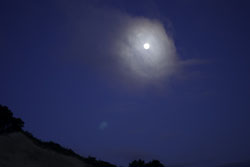2/24/12, Friday, was warmer than on our scouting hike. The temperature ranged from about 63F down to 55F. The sky was clear, but got partial clouds later. Out of 31 people who made reservations or were on the waitlist, 13 canceled, 11-16 expected, only 4 showed up, including a friend of one of the two docents (JW and LE) who joined us.
We started off at 4:40. We stopped at the northwest corner footbridge of Alpine Pond, and found a pair of newts in amplexus. Rounding the corner, we stopped to check the view, and found a male Bufflehead, Ring-necked Duck, and a female Hooded Merganser sharing a resting spot. Red-winged Blackbirds were singing, and one treefrog called briefly.
At 5:00 we came out into the open on Ipiwa Trail. A coyote, presumably the same one that we’d seen on the 18th, patrolled the ridge, and a few deer were downhill. We examined the various animal scats along the way. It was clear enough to see the ocean as we approached the overlook. We turned left to have dinner at 5:20 along the wide trail above, deciding not to disturb the curious deer ahead of us by making another left. Three heads peered over the rise of the trail, and a few browsed to the north.
Close to 6:00, around sunset, we proceeded back down to the overlook and around the chaparral. Silk Tassels were showing tassels, manzanita had blossoms, and buckbrush was in bloom and fragrant. We stopped to have a sniff of a Holly-leafed Cherry (Prunus ilicifolia) leaf, which smells like almond. According to the USDA, native peoples did use parts of this tree as food and medicine, prepared properly. Parts are toxic, and the leaves contain hydrocyanic acid (explaining the smell). A question came up about other organisms with cyanide, and I mentioned the millipedes we often see. We also had a discussion about using wild plants (in places where it is legal to collect/pick) for food, and the possible dangers of doing so.
We heard a Great-horned Owl briefly; as we waited unsuccessfully for more calls, a pair of Wrentits in the shrubs near us had a long twittering conversation.
At 6:15 we reached the Sunny Jim intersection, and at 6:40 we stopped before turning right to go to Horseshoe Lake. Venus, Jupiter and the crescent moon were up. A bat or two flew by. [edit: There was also a brush rabbit who, in typical rabbit style, remained mostly motionless even though out in the open with eyeshine reflecting off my red flashlight. ] We could hear the treefrogs calling, and we played calls of Sierran Treefrog and California Red-legged Frog for the participants. Someone asked about bullfrogs, and we explained that they aren’t native here in California, and eat the native frogs and other animals.
This time we walked along the shoreline trail, but in one spot that was accessible, I didn’t see any newts or frogs. We went back to the bridge, and while some were star watching, I checked the area below the bench. There were a couple of newts in the water, but I couldn’t find any treefrogs visually, despite a few of them calling from nearby. The bulk of them seemed to be calling from the other sides of the lake, and many more called than on Saturday. It was far short of being deafening though. KG spotted a large owl flying by high overhead.
It took from 7:20 to 7:40 to get back to the big intersection, then to 7:55 to the overlook. We found newts still in land phase, around four from here back into the woods. One, near the overlook, was right next to a very cold banana slug. It had gotten windy, and we didn’t hear any more owls.
We looked for the small dirt turret with two beetle larvae holes, and found those along with some nearby small, fluorescent honey mushrooms. There were around seven Polydesmid millipedes (probably Xystocheir dissecta taibona, common in Santa Clara County according to Rowland Shelley). The first one was in the area that we had stopped at, and I picked it up to show. This one felt threatened for some reason, as it released defensive secretions, a brown goo. Someone remarked that it had pooped, so being me (and knowing that some millipede poop looks like pellets), I smelled it to see if it had the odor of almonds. It did, so everyone had a sniff. It was a nice connection to the Holly-leafed Cherry. These millipedes don’t have eyes, and they produce hydrogen cyanide.
Back at the Alpine Pond crossroads at 8:45, we went around the east side this time, stopping at the deck to try for bats over the water, without luck. Some frogs called.
We arrived back at the lot a bit before 9:00.
==
See Secret Weapons: Defenses of Insects, Spiders, Scorpions, and Other Many-Legged Creatures , page 43, by Eisner for more on millipedes and cyanide.

